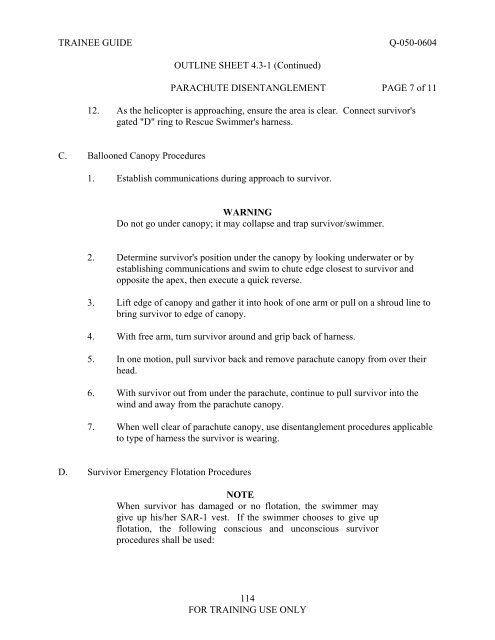Tg4-3 cng1.pdf - NETC - The US Navy
Tg4-3 cng1.pdf - NETC - The US Navy
Tg4-3 cng1.pdf - NETC - The US Navy
Create successful ePaper yourself
Turn your PDF publications into a flip-book with our unique Google optimized e-Paper software.
TRAINEE GUIDE Q-050-0604<br />
OUTLINE SHEET 4.3-1 (Continued)<br />
PARACHUTE DISENTANGLEMENT PAGE 7 of 11<br />
12. As the helicopter is approaching, ensure the area is clear. Connect survivor's<br />
gated "D" ring to Rescue Swimmer's harness.<br />
C. Ballooned Canopy Procedures<br />
1. Establish communications during approach to survivor.<br />
WARNING<br />
Do not go under canopy; it may collapse and trap survivor/swimmer.<br />
2. Determine survivor's position under the canopy by looking underwater or by<br />
establishing communications and swim to chute edge closest to survivor and<br />
opposite the apex, then execute a quick reverse.<br />
3. Lift edge of canopy and gather it into hook of one arm or pull on a shroud line to<br />
bring survivor to edge of canopy.<br />
4. With free arm, turn survivor around and grip back of harness.<br />
5. In one motion, pull survivor back and remove parachute canopy from over their<br />
head.<br />
6. With survivor out from under the parachute, continue to pull survivor into the<br />
wind and away from the parachute canopy.<br />
7. When well clear of parachute canopy, use disentanglement procedures applicable<br />
to type of harness the survivor is wearing.<br />
D. Survivor Emergency Flotation Procedures<br />
NOTE<br />
When survivor has damaged or no flotation, the swimmer may<br />
give up his/her SAR-1 vest. If the swimmer chooses to give up<br />
flotation, the following conscious and unconscious survivor<br />
procedures shall be used:<br />
114<br />
FOR TRAINING <strong>US</strong>E ONLY









